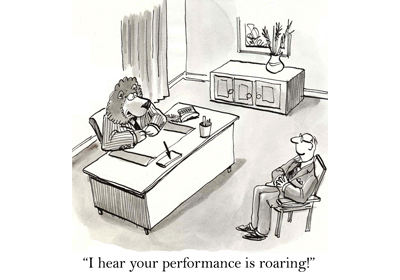Have you noticed that some of the great stuff you want to achieve in business is not easily measured? It’s easy to measure quantities: of money, production, sales calls, numbers of time the phone rings before it’s answered, and because it’s easier, businesses tend to default to measuring and managing only straightforwardly quantifiable things.
Quantifiable stuff has to be measured in business, it’s true. You’d be failing in your accountability to your bosses, bankers and shareholders if you didn’t do it. And by and large most business leaders make a pretty good job of measuring the results these people wish to see.
But these alone don’t tell you that everything you want to happen is happening. What about teamwork, values, customer service, people’s attitudes? Of course, if a thing is worth doing, the value will fall to the bottom line – eventually. However, bottom-line results take longer to show up – they are ‘lagging indicators’ of business success. By the time you’ve missed your revenue target, it’s by definition too late to do something about it this time around. And it’s sometimes possible to produce apparently good bottom-line results by using inappropriate business practices which will in the longer term actually damage your business.
So how do you measure the ‘other stuff’?
How do you measure all those good things you instinctively know are at the root of a successful, satisfying, sustainable business? If you ‘know it when you see it’, then you are using a set of criteria. You might dismiss it as ‘gut feel’, but you will find there is a remarkable correlation between people’s ‘gut feel’ about what constitutes great teamwork, or good customer service, for example. People are by and large operating from a set of shared criteria.
With a bit of rigorous thinking, you can come up with a set of clear objective statements for the target behaviour. Then it’s a short step from being able to note instances of the behaviour, to setting targets for increasing the incidence of the behaviour, and to creating plans for improving performance.
What might it look like in practice?
Let’s look at performance. Some targets – what concrete, tangible, measurable results you want to achieve – are easy to come up with. How often though do you also set clearly measurable expectations for how people produce results? How would it be for example if you assessed your organisation against the following standards:
- Underperformance is not tolerated
- People never make excuses for underperformance
- We don’t waste time doing irrelevant things
- The results of the business are in line with its strategy
- Only activity which supports the strategy is recognised and rewarded
Using clear statements like these of the ideal state you would like to see, you can make an honest assessment of where you are in your business and where you would like to get to, without it being too intimidating or abstract for people to grasp. The gap between where you are now and where you aspire to be gives you the basic material to draw up a credible action plan.
Some pitfalls…
There are two major pitfalls to avoid. Be careful to use the statements, not to criticise and complain about the current state of the business, but to inspire people, and as the raw material for building an effective way forward. And be willing to use professional help where needed, especially when dealing with the need to shift fundamental mindsets and deep-rooted excuses for underperformance.
Staying on track
Whether you are dealing with a whole organisation, a team, or an individual, with a bit of help you can always define very accurately what you are looking for. Sometimes it helps to have someone ‘interview’ you to be able to put words to your ’gut feel’. The effort is well worth it, though. What you end up with is a clear articulation of your values, standards and expectations that can be measured and therefore managed proactively. This provides you and your staff with a clear guide to the steps you need to take to achieve success. And you don’t need to wait for the end of the year, or the quarter, to know you are on track!
[callout title=”Do you have clear statements of how you’d like people to behave in your organisation?” button=”Contact us” link=”/contact/” buttoncolor=”white, yellow, orange, red, blue, green, gray, black, alternative-1, alternative-2, alternative-3″ target=”_blank or _self”]We’d love to hear from you…[/callout]
